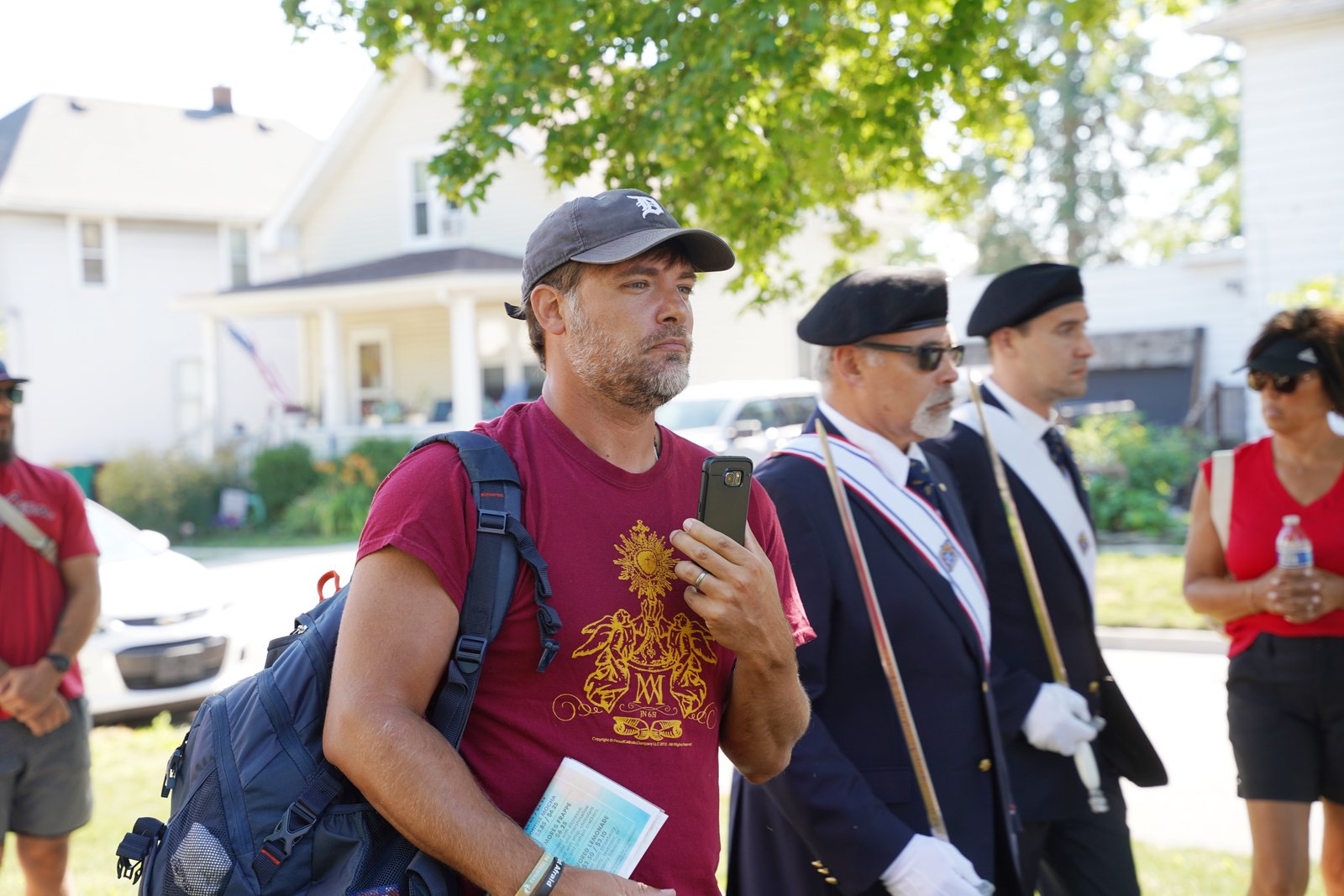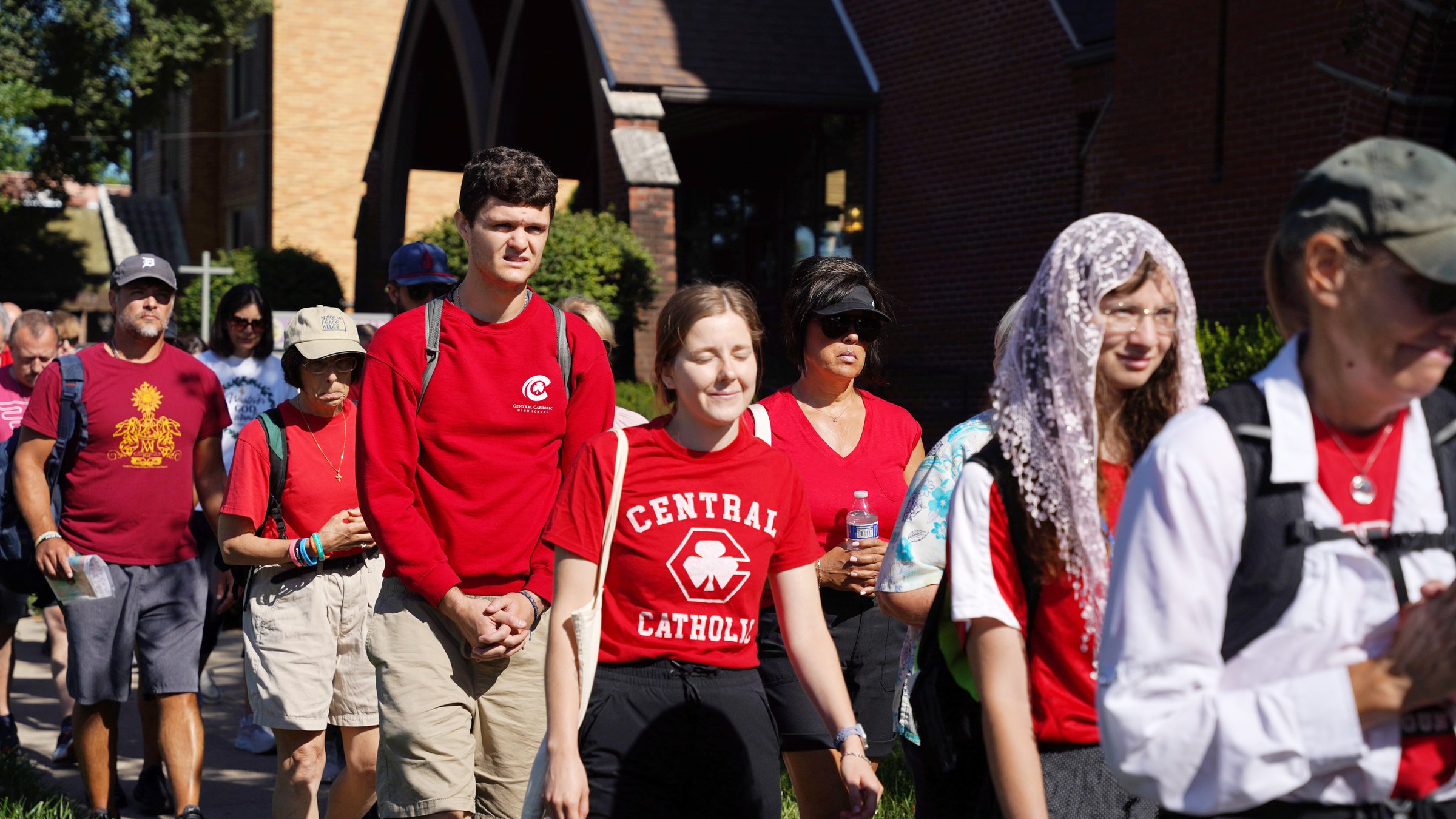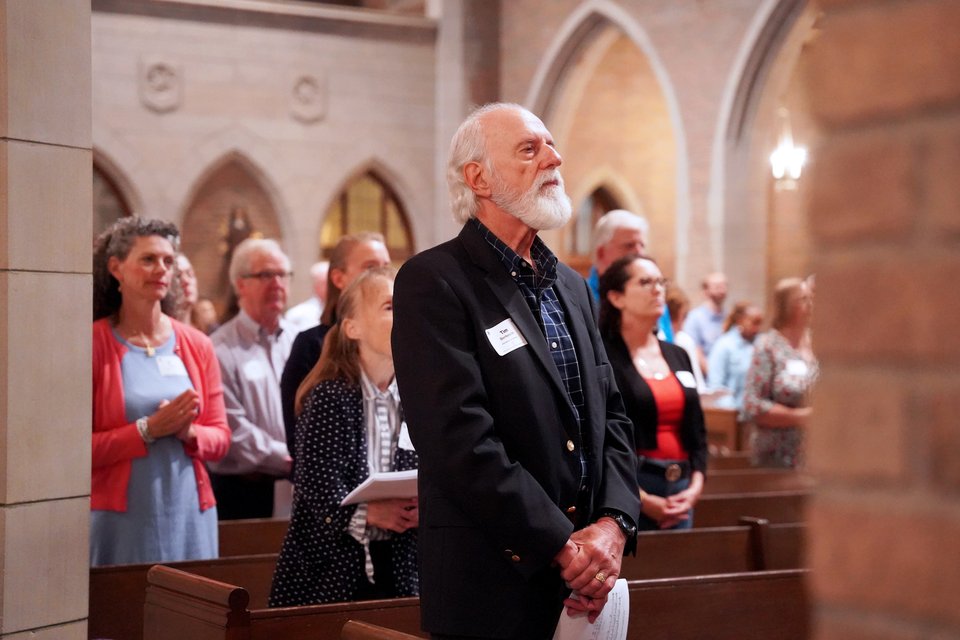'Rise from the Ashes' pilgrimage includes Eucharistic processions, liturgies uniting pilgrims to National Eucharistic Congress
MONROE — For the fifth consecutive year, pilgrims from the Monroe area are following in the footsteps of the missionary priests who first graced this peninsula and walked from Monroe to Detroit.
Only this year, the “Rise from the Ashes,” pilgrimage, taking place July 19-21, is incorporating three Eucharistic processions along its 38-mile trek, uniting itself to the National Eucharistic Congress taking place in Indianapolis.
“It’s the first time we are incorporating Eucharistic processions into ‘Rise from the Ashes,’” organizer Joe Boggs, a member of St. John the Baptist Parish in Monroe, told Detroit Catholic. “It’s something we’ve talked about doing from the beginning, but it seemed so natural this year and we hope it continues for years to come.”
“Rise from the Ashes,” — the name taken from the Fr. Gabriel Richard-coined Detroit city motto — started with Eucharistic adoration at St. Mary of the Immaculate Conception Parish in downtown Monroe, where Fr. David Burgard led pilgrims and other Eucharistic adorers in a procession with the Blessed Sacrament down Elm Street.

The Eucharistic procession stopped at the corner of Elm and Riverview, where Fr. Burgard blessed the congregation with the Eucharist in a monstrance before the 20 red-shirted pilgrims turned north and continued their journey.
The pilgrimage is an opportunity to give witness to Christ in a public way and is proof one doesn’t need to go off to far-flung places to spend time with the Lord, explained McKenzie Ganache, a parishioner of St. Michael the Archangel Parish in Monroe.
“It’s a beautiful witness. I’ve been part of several pilgrimages around the world; it’s not as glamorous, the thought of walking from Monroe, Michigan, but that's the beauty in it, the hidden beauty,” Ganache said. “It’s not for show, not for the locations you are going to; it’s to encounter the Lord and the beauty of His creation and His people, and that is more beautiful than going to places like Rome or Assisi or Jerusalem. To know we can meet Him here in person, wherever.”
The pilgrimage progressed 16 miles north to St. Mary, Our Lady of the Annunciation Parish in Rockwood, which will host a “Set Afire” praise and Eucharistic adoration session at 6:30 p.m.

The group will stay the night at St. Mary’s, spending time in fellowship, eating and playing games, before getting up early in the morning to hit the road again, journeying 11 miles northeast toward the Detroit River and St. Vincent Pallotti Parish in Wyandotte.
The pilgrims and others will take part in a half-mile Eucharistic procession through Wyandotte after the 4 p.m. Mass, before staying the night at the Knights of Columbus Hall in Wyandotte.
Beyond giving a public witness to Christ — especially during the Eucharistic processions — the most gratifying part of the pilgrimage is spending time in communion with other pilgrims, journeying with them and getting to know them more, Boggs said.
“I think the most important part, besides the penance and prayer that comes along with pilgrimages, is the people,” Boggs said, “the people you meet along the journey, not just as part of the group, but those you encounter who are asking questions about what’s going on here and also the people you encounter in a deeper fashion that you’re on pilgrimage with. These are individuals that I now know more deeply.”

The fact the pilgrimage is happening during the National Eucharistic Congress in Indianapolis — itself the culmination of four cross-country Eucharistic processions, which converged on Lucas Oil Stadium on July 17 to open the congress — gives the Monroe-to-Detroit pilgrimage all the more meaning, Ganache said, especially with the addition of the three Eucharistic processions.
“One of my close college friends led the Seton Route (the eastern route that started in New Haven, Conn.), so I was watching her do it and living through her experience,” Ganache said. “I was grateful to be here and at least participate in walking my own way for people who are at the congress and for people all over the world, like immigrants or refugees who can’t participate but would love to participate in their own countries.”
Ganache expects the 38-mile trek to be restful, not in the physical sense, but in the spiritual sense, dedicating all that time walking to focusing on God and God’s creation, even with the discomfort that comes from spending three days on the road.
“It’s a beautiful act of intentionally suffering to lift it up,” Ganache said. “It’s an opportunity to unite ourselves to the Body of Christ and be his Church on earth. It’s a gift to participate, even in a small way.”

On Sunday morning, the pilgrims will be back at it, walking the final 11 miles to the Basilica of Ste. Anne de Detroit by 11:30 a.m., where Fr. Craig Giera, director of priestly vocations for the Archdiocese of Detroit, will lead the third and final Eucharistic procession of the pilgrimage.
Three days, 20 pilgrims, 38 miles, and countless souls touched — it’s not for everybody, but the ones who have braved the trip in the past say it’s worth it.
“It’s so counter-cultural to walk, with intent, through the streets, with the monstrance in their priests’ hands; that grabs people's attention, whether they are Catholic or not,” Ganache said. “It makes people wonder and awe, and that leads to natural questions and hopefully even tingling in people’s souls. It helps people who are walking be more convicted that it’s Jesus we’re walking with, and it helps people think, 'There has to be something real here.’ And to those Catholics who might not believe in the True Presence, it might get them to second guess themselves.”

It might be difficult to track how an encounter with Christ on the streets during the "Rise from the Ashes" pilgrimage might affect those who don't yet know or believe in the power of the Eucharist, or even the National Eucharistic Revival itself.
But Boggs is certain these next three days spent on the road and in the company of others will do wonders for the lives of the pilgrims.
“I just know they will grow in a love for the Lord, especially in this Eucharistic revival,” Boggs said. “We need to be His hands and feet, and if we truly understand how Jesus transforms the bread and wine into the Body and Blood of Jesus, we can transform ourselves to the people we need to be in our community.”
Copy Permalink
Liturgy and devotions












